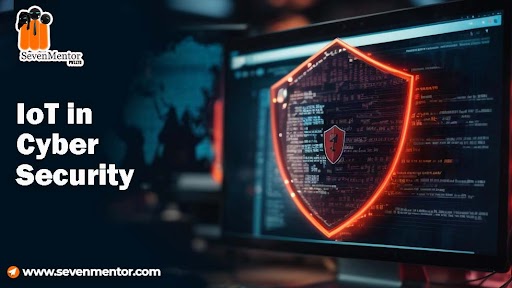IoT in Cyber Security
The Internet of Things (IoT in Cyber Security) refers to a network of physical devices that use sensors, software, and other technologies to connect and exchange data with other devices and systems over the Internet. These devices range from ordinary household items to sophisticated industrial tools.
For Free Demo classes Call: 020 7117 2515
Registration Link: Click Here!
2. Key Components:
- Sensors/Devices: Collect data from their environment. This could be as simple as a temperature reading or as complex as a full video feed.
- Connectivity: Devices need to be connected to a cloud infrastructure, usually via Wi-Fi, Bluetooth, cellular networks, satellite, or direct-wired connections.
- Data Processing: Data collected by devices is processed either locally or in the cloud. This could involve simple analysis or complex algorithms for pattern recognition.
- User Interface: The information needs to be available to the end-users in some way, which can be through an alert to the user, a display on a dashboard, or triggering a process or action.
3. IoT Usage Examples:
- Smart Homes: IoT devices control lighting, heating, air conditioning, and security systems.
- Healthcare: Wearable devices for monitoring patient health metrics.
- Industrial and Manufacturing: IoT sensors for predictive maintenance of machinery, and to monitor production lines.
- Agriculture: Sensors for monitoring soil moisture and crop growth.
- Smart Cities: IoT applications include monitoring and managing traffic, waste management, and energy usage.
4. Benefits of IoT:
- Efficiency and Cost Reduction: By automating and optimizing tasks.
- Data-Driven Insights: Big data analytics from IoT devices can lead to more informed decision-making.
- Improved Safety and Security: Particularly in industrial settings.
- Remote Monitoring and Control: Offers convenience and the ability to react quickly to problems.
5. Challenges in IoT:
- Security: IoT devices can be vulnerable to hacking and other cyber threats.
- Privacy: Concerns around the data collected, especially in consumer settings.
- Interoperability: The need for standardization among different devices and platforms.
- Scalability: The infrastructure needed to handle large amounts of data from countless devices.
For Free Demo classes Call: 020 7117 2515
Registration Link: Click Here!
Attacks on IoT Devices
1. Types of Attacks:
- Botnet Attacks: IoT devices are infected with malware and controlled remotely to launch attacks like DDoS (Distributed Denial of Service).
- Data and Identity Theft: Hackers access sensitive personal information stored on IoT devices.
- Man-in-the-Middle Attacks: Unauthorized interception of data transmission between IoT devices and the network.
- Firmware Hijacking: Compromising the firmware of an IoT device to take control of it.
- Physical Attacks: Tampering with physical components of IoT devices.
2. Security Vulnerabilities:
- Weak Passwords: Use of default or easily guessable passwords.
- Lack of Encryption: Data transmitted without encryption is susceptible to interception.
- Insecure Ecosystems: Entire networks can be vulnerable if one device is compromised.
- Lack of Regular Updates: Outdated software without the latest security patches.
3. Prevention and Mitigation:
- Strong Authentication Protocols: Use strong, unique passwords and consider two-factor authentication.
- Regular Software Updates: Keep the device’s firmware and software up to date.
- Network Security: Secure network connections, use firewalls, and separate IoT devices onto their own network segment.
- Encryption: Encrypt data both at rest and in transit.
- Awareness and Training: Educate users about the risks and safe practices of IoT device usage.
For Free Demo classes Call: 020 7117 2515
Registration Link: Cyber Security Course in Pune!
4. Future of IoT Security:
- AI and Machine Learning: To detect and respond to threats in real-time.
- Legislation and Regulations: Establishing standards for IoT security.
- Advanced Cryptography: Developing more robust encryption techniques.
- Secure by Design: Incorporating security at the hardware and firmware level during the design phase of IoT devices.
Do watch our video on Cyber Security: Click Here
Important Questions For Cyber Security Exam From IOT
When preparing for a cybersecurity exam focusing on the Internet of Things (IoT), it’s crucial to cover a range of topics that encompass both the technical and strategic aspects of IoT security. Here are some important questions that could be relevant for such an exam:
- What are the common security vulnerabilities associated with IoT devices?
- How do the characteristics of IoT devices contribute to their security challenges?
- Explain how a botnet works in the context of IoT devices.
- What is a Distributed Denial of Service (DDoS) attack and how can IoT devices be exploited in such attacks?
- Explain man-in-the-middle attacks in IoT networks.
- Describe how physical attacks on IoT devices can compromise security.
- What are the best practices for securing IoT devices?
- How can network segmentation be used to enhance IoT security?
Author:-
Rajat Sharma
Call the Trainer and Book your free demo Class For Cyber Security
Call now!!!
| SevenMentor Pvt Ltd.
© Copyright 2021 | SevenMentor Pvt Ltd.

